Paul Gilster's Blog, page 101
August 28, 2018
A Three Part Model for Jupiter’s Formation
Meteorites have proven a useful tool for probing the nature of the early Solar System. Although I missed it at the time, Thomas Kruijer (University of Münster) and colleagues announced results last year from their study of the age of Jupiter based on measuring isotopes in meteorites. The age of Jupiter is an open question, but because current formation models have gas giants forming large solid cores and then rapidly accreting gas, the assumption is that the circumstellar disk could not have been depleted of its gas by the time Jupiter’s formation was complete.
A gas giant must form, in other words, fairly rapidly, and the Kruijer paper offered a deeper look into the conditions of the surrounding disk during the process. The researchers were able to identify “…two genetically distinct nebular reservoirs that coexisted and remained spatially separated between ~1 My and ~3-4 My after Solar System formation.” Even that early in the formation of the Solar System, two bands of relatively small bodies had emerged.
We can imagine Jupiter growing and becoming the blocking factor between the inner and outer parts of the circumstellar disk. The idea has triggered further work from Yann Alibert (University of Bern), working with a team of researchers from both the University of Zürich and ETH Zürich, who delve into a gas giant formation model that adds considerable detail to older concepts.
A Jupiter growing from 20 to 50 Earth masses would explain the Jupiter ‘barrier,’ for it would create a higher density of dust that could trap pebbles outside its orbit. The separation would remain for a time because only when the planet grew large enough would it reach the amount of mass necessary to perturb pebbles, rocks and other debris inward, thus mixing the regions.
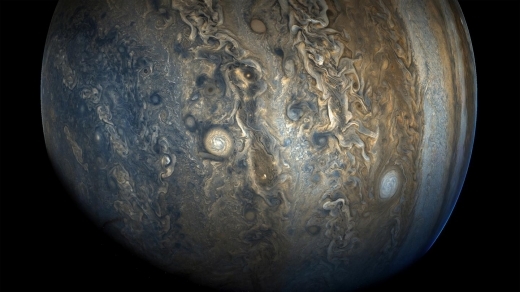
Image: Jupiter’s southern hemisphere photographed by NASA’s Juno spacecraft. Credit: NASA/JPL-Caltech/SwRI/MSSS/Gerald Eichstaedt/Sean Doran.
What Alibert and team didn’t like was the timing, which the meteorite data indicated was a two million year window. “How could it have taken two million years for Jupiter to grow from 20 to 50 Earth masses?” asks Julia Venturini (University of Zürich). A good question, and one from which the Alibert study grew. Out of this dissatisfaction has emerged a three-part model based on the idea that different kinds of bodies contribute mass and energy as the planet forms.
What we have lacked before now is an idea of the size of the accreting materials. In the Alibert model, the process works like this: Growth of the planetary embryo begins by accreting pebbles at the centimeter scale, building a core during an initial period lasting about 1 million years. A period of slower accretion — this time of rocks at kilometer size, or planetesimals — now follows. This period lasts 2 million years, and accounts for the period that turns up in the Kruijer meteorite studies.
As planetesimals strike the young, growing planet, they impart heat and energy. Says Alibert: “During the first stage the pebbles brought the mass: In the second phase, the planetesimals also added a bit of mass, but what is more important, they brought energy.”
This energy is crucial to the model, because it heats the atmosphere of the infant Jupiter enough to prevent contraction as well as further gas accretion. This delay in gas accretion allows slow the growth from 20 to 50 Earth masses and fits nicely with the meteorite data. It explains why the time the planet spent in this mass range was so unexpectedly long.
In 3 million years, Jupiter reaches 50 Earth masses, and at this point, the third phase of formation can occur, dominated by runaway gas accretion and building toward a planet that is what we see today, a giant of 300 Earth masses. Jupiter could be said, then, to have had a period of ‘arrested development’ as kilometer-sized blocks injected high energy, slowing the accretion of gas. Small pebbles build a core, planetesimals provide heat that delays gas accretion, which finally takes off as the planet cools and swells toward its current size.
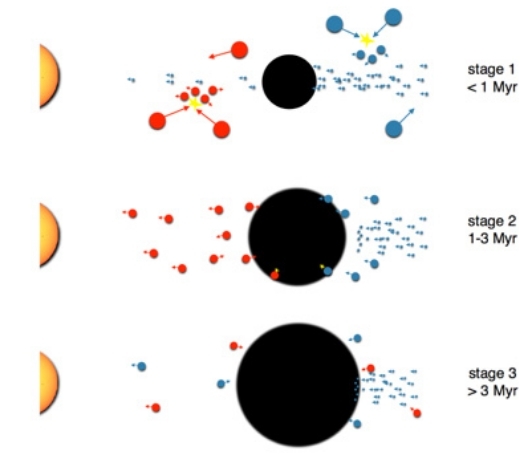
Image: This image shows the formation of Jupiter in 3 stages. Stage 1 / until 1 million years: Jupiter grows by accretion of pebbles (blue dots). Large primordial planetesimals (big red dots) show high collision velocities (red arrows) leading to destructive collisions (yellow) and producing small, second generation planetesimals (small red dots). Stage 2 / 1-3 million years: The energy resulting from the accretion of small planetesimals prevents rapid gas accumulation and thus rapid growth (gray arrows). Stage 3 / beyond 3 million years: Jupiter is massive enough to accrete large amounts of gas. Credit: UniBE.
This multi-phase hypothesis for gas giant formation explains how the division between inner and outer Solar System found so early in the data could arise during the 2-million year window, and also explains why the growth rate could be so slow. From pebbles to planetesimals, the new gas giant theory could offer insights as well into exoplanet formation. But will it fit other planets in our own Solar System? Applying these concepts in particular to Uranus and Neptune should be interesting, but Alibert and team think the data fit. We should see future work on the idea.
The paper is Alibert et al., “The formation of Jupiter by hybrid pebble–planetesimal accretion,” Nature Astronomy 27 August 2018 (abstract). The Kruijer paper is “Age of Jupiter inferred from the distinct genetics and formation times of meteorites,” Proceedings of the National Academy of Sciences Vol. 114, Issue 26 (June, 2017). Abstract.






August 27, 2018
OSIRIS-REx: Looking Forward & Looking Back
The OSIRIS-REx spacecraft carries three cameras as it makes its way to the asteroid called Bennu, a suite that is collectively known as the OSIRIS-REx Camera Suite (OCAMS). So now we’re into the realm of OSIRIS-REx acronyms, and these should become familiar in coming months just as New Horizons’ instruments like LORRI (Long Range Reconnaissance Imager) and PEPSSI (Pluto Energetic Particle Spectrometer Science Investigation) did enroute to Pluto.
The camera called PolyCam is responsible for the image below, an animation showing the target acquired on August 17, at a distance of 2.25 million kilometers. PolyCam will serve as a reconnaissance camera as the spacecraft nears Bennu, but its other role is that illustrated here, as a long-range acquisition camera whose first visual of the target has been in the works for nine weeks. That’s the length of the planning process, testing, reviews and code upload.
“Right now, Bennu just looks like a star, a point source,” said Carl Hergenrother, UA Lunar and Planetary Laboratory staff scientist and OSIRIS-REx astronomy working group lead who proposed Bennu as the mission target during the early planning phase when the asteroid was simply known as 1999 RQ36. “That will change in November, when we will begin detailed observations and we’ll start seeing craters and boulders. You could say that’s when our asteroid will transition from being an astronomical object to an actual geological object.”
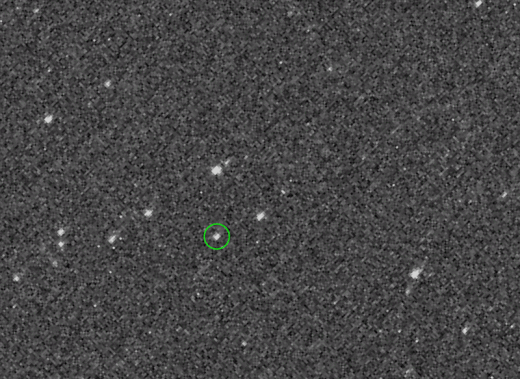
Image: For this animation, OSIRIS-REx image scientists combined five exposures of asteroid Bennu taken by the spacecraft’s PolyCam camera. At this distance, almost six times of that between the Earth and the moon, Bennu is just a point source, indistinguishable from a star other than the way it moves against the star field in the background. This will change dramatically once the spacecraft comes closer and makes its rendezvous with the asteroid in December. Credit: NASA/Goddard/University of Arizona.
We’re 98 days from arrival at Bennu on December 3. OSIRIS-REx controllers will be increasingly busy as the approach phase intensifies, as a glance at the approach activities shows. Here’s what’s ahead during this period, as presented in an LPL news release:
Regularly observe the area around the asteroid to search for dust plumes and natural satellites, and study Bennu’s light and spectral properties;
Execute a series of four asteroid approach maneuvers, beginning on Oct. 1, slowing the spacecraft to match Bennu’s speed and trajectory;
Jettison the protective cover of the spacecraft’s sampling arm in mid-October and subsequently extend and image the arm for the first time in flight;
Use OCAMS to reveal the asteroid’s overall shape in late October and begin detecting Bennu’s surface features in mid-November.
As for the rest of those acronyms beyond the OCAMS camera suite, we will be hearing more and more about a thermal spectrometer (OTES), the OVIRS visible and infrared spectrometer, the OLA laser altimeter and the REXIS X-ray spectrometer. On the OSIRIS-REx acronym itself, we can untangle it this way: Origins Spectral Interpretation Resource Identification Security Regolith Explorer.
Quite a mouthful, but it does condense the mission goals: To return a sample of a carbon-rich asteroid, define its properties, identify its chemistry and mineralogy, measure the Yarkovsky Effect on nearby asteroids (caused by uneven heating on a rotating asteroid, and capable of changing an asteroid trajectory), and document the morphology, geochemistry and spectral properties of the surface material. Along the way, we’ve already had some spectacular views.

Image: A color composite image of Earth taken on Sept. 22 by the MapCam camera on NASA’s OSIRIS-REx spacecraft. This image was taken just hours after the spacecraft completed its Earth Gravity Assist at a range of approximately 170,000 kilometers. MapCam is part of the OSIRIS-REx Camera Suite (OCAMS) operated by the University of Arizona. Visible in this image are the Pacific Ocean and several familiar land masses, including Australia in the lower left, and Baja California and the southwestern United States in the upper right. The dark vertical streaks at the top of the image are caused by short exposure times (less than three milliseconds). Short exposure times are required for imaging an object as bright as Earth, but are not anticipated for an object as dark as the asteroid Bennu, which the camera was designed to image. Date Taken: Sept. 22, 2017. Instrument Used: OCAMS (MapCam). Credit: NASA/Goddard/University of Arizona.
The peoples of the ancient Nile delta saw the Egyptian god Osiris as being behind the spread of agriculture, therefore considering this deity to be a bringer of life. Thus the determination to come up with the name OSIRIS in this mission. After all, OSIRIS-REx will be returning samples of the kind of asteroid that may contain organics. Ultimately, the origin of life on our planet may be tied into delivery of materials from such asteroids, so the name seems appropriate.
Bear in mind that for all its interest, Bennu is a tiny world, no more than 500 meters in diameter. That will make Bennu the smallest object ever orbited by a spacecraft. OSIRIS-REx will map the asteroid in its first month after arrival, allowing for the first direct measurement of its mass. Sample collection is scheduled to begin in early July 2020, with the spacecraft returning to Earth to eject its Sample Return Capsule for a landing in the Utah desert in September, 2023.
“The story of this asteroid is the story of the solar system,” says OCAMS instrument scientist Bashar Rizk. “When we understand Bennu, we will understand something fundamental about our solar system.”
Meanwhile, we continue to monitor the Japanese Hayabusa 2 spacecraft, which arrived at asteroid Ryugu in late June, and on which controllers have chosen a landing site. The spacecraft’s lander, the Mobile Asteroid Surface Scout (MASCOT), is scheduled to touch down on October 3 as part of the sample-return mission. More on Hayabusa 2 soon as we continue the exploration of near-Earth objects not only for the insights they give us into the early Solar System but also their potential for resource extraction and our need for planetary protection.






August 24, 2018
GW170817: An Extragalactic SETI Opportunity?
While we pursue SETI by listening to and looking at nearby stars within our own galaxy, the possibility of going extragalactic remains. Consider the activity at Penn State, where Jason Wright and colleagues Matthew Povich and Steinn Sigurðsson have been conducting the Glimpsing Heat from Alien Technologies (G-HAT) project, looking at infrared data from both the Wide-field Infrared Survey Explorer mission (WISE) and the Spitzer Space Telescope. An unusual infrared signature could conceivably be a sign of waste heat from such a culture.
Turning up the signature of a Kardashev Type III civilization, one capable of tapping the energy output of an entire galaxy, would be a spectacular find, a search well worth continuing. But there are other ways of looking for evidence that might fit what Wright has written about in terms of ‘Schelling points.’ The idea is to draw on game theory to analyze a situation in which two players who cannot communicate are engaged in a cooperative activity. They are, perhaps, asking themselves questions like when to transmit to a given target and in which directions to listen.

Thus we look at SETI as a mutual activity, and the game theory analyzed by the American economist Thomas Schelling comes into play. Wright looks at this in a paper called “Exoplanets and SETI” (citation below), noting that one of Schelling’s examples is particularly germane to SETI: Imagine you find yourself in a large city and are looking for someone who is also looking for you. Let me quote Wright on this:
Guessing the times and places to meet in the city, and guessing the frequencies to tune to in radio SETI, are superior strategies to random ones. In the city, this might include the locations of famous landmarks and times that bells chime or other coordinated actions occur; in radio SETI this might mean astrophysically significant frequencies and their multiples. Makovetskii (1980) called this a “mutual strategy of search” for “synchrosignals”(Makovetskii 1977), and Filippova et al. (1991) described this concept as a “convergent strategy of mutual searches” for SETI (both apparently unaware of Schelling’s prior art).
Image: Nobel Prize-winning economist and arms control theorist Thomas Schelling (1921-2016). Credit: Harvard University.
It is clearly useful to identify Schelling points when thinking about where to observe if we are looking for a SETI signal. We started SETI off back in the Project Ozma days by looking for Sun-like stars that might host habitable planets like our own, and we have target lists for continuing searches today. Would ETI do the same? The ecliptic might be a good place to look for a signal because Earth would transit the Sun from the viewpoint of astronomers around distant stars there. Another Schelling point: Exoplanet transits, which could be considered a communications window for any civilization deliberately trying to draw our attention.
Notice that these Schelling points assume a civilization that is attempting to be found, which is what Yuki Nishino and Naoki Seto (Kyoto University) do in a paper that extends Schelling to other galaxies. Whereas finding waste heat from a Type III civilization would assume no intent to communicate, Nishino and Seto ask whether there are any windows that an ETI culture might choose if it wanted to announce its presence to another galaxy. Given the challenge of the distances involved, such a signal would have to be sent at an obvious Schelling point.
Let’s leave aside the unknowable issue of motives (who knows why an alien species might want to broadcast its existence to beings in a culture millions of light years away?), and ask whether there are any obvious Schelling points that civilization might choose. The authors go through the literature, finding proponents of synchronizing signals via supernovae or gamma rays bursts, but here they question the timing accuracy involved and doubt the utility of the concept.
But the researchers argue that there is one natural phenomenon that could be forecast well enough in advance to allow a civilization to synchronize a signal: A binary neutron star merger. They point to the detection by the LIGO-Virgo network of a gravitational wave from the binary neutron star (BNS) system GW170817. Soon after the detection, the host galaxy NCG4993 was identified by electromagnetic observations, at a distance of ~40 Mpc. Nishino and Seto believe that a sufficiently advanced civilization could predict such a merger with high accuracy:
These Galactic BNSs contain recycled pulsars as one of the binary components, allowing high-precision measurements of the binary parameters. If ETI can detect the recycled pulsar of an inspiraling BNS system in their galaxy, they can also make a high-precision measurement for the quantities required for the signal transmission to be synchronized with the BNS merger. This synchronization scheme seems reasonable to us as a signal receiver…
A natural event lights up in a way sure to draw the attention of astronomers in other galaxies. A signal timed to coincide with it is sent to take advantage of the attention it has created.
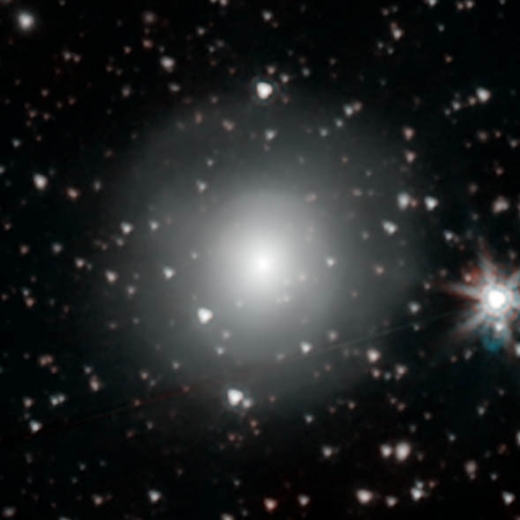
Image: NASA’s Spitzer Space Telescope has provisionally detected the faint afterglow of the explosive merger of two neutron stars in the galaxy NGC 4993. The event, labeled GW170817, was initially detected nearly simultaneously in gravitational waves and gamma rays, but subsequent observations by many dozens of telescopes have monitored its afterglow across the entire spectrum of light. Spitzer’s observation on September 29th comes late in the game, just over 6 weeks after the event was first seen, but if this weak detection is verified, it will play an important role in helping astronomers understand how many of the heaviest elements in the periodic table are created in explosive neutron star mergers. This image is a color composite of the 3.6 and 4.5 micron channels of the Spitzer IRAC instrument, rendered in cyan and red. The faint light from the explosion is to faint to be easily seen mixed in the light of the other stars in the galaxy. Credit: JPL/Caltech.
Thus we have a mechanism for creating a targeted signal that could announce the existence of a civilization to another galaxy, for whatever purposes it chose to do this. The detection of the cataclysmic binary neutron star merger would be accompanied shortly thereafter by a communication signal meant to be detected by astronomers studying the merger event itself. The authors estimate that a 1 terawatt transmitter in a galaxy 130 million light years away could send 10 megabytes of data to a receiver like the Square Kilometer Array.
The odds of a civilization choosing to deploy such methods seem long indeed, but it fascinates me to see that gravitational wave astronomy is now beginning to work its way into the SETI discussion. Thus the authors discuss the synchronization of the signal:
… the ETI would be able to estimate the location and the epoch of the highly energetic event in advance. Most optimistically, we might actually find an artificial signal by reanalyzing the electromagnetic data already taken from GW170817. Additionally, the LIGO-Virgo network will start the next observational run in early 2019, and a new BNS merger might be identified. The early and deep radio observation for its host galaxy might also be worth considering from the perspective of SETI.
The authors also note that to demonstrate the synchronization of the signal (i.e., to show that it was not a coincidence), the extraterrestrial civilization might include the intrinsic information of the particular binary neutron star merger involved. It’s an ingenious notion that extends directed beacon signals into the extragalactic realm and one that also calls into question the issue of galactic gravitational lensing. In any case, the transmitting culture is adjusting the timing and direction of its transmissions to coincide with the arrival of the gravitational wave signal.
Given the year-long observations of the GW170817 afterglow, Nishino and Seto argue that the difference between the arrival time of the GW signal and the artificial signal should be in the range of one year. Thus a transient, flaring phenomenon drawing our attention could become the announcement of a SETI opportunity, with a binary neutron star merger the brightest transient that can be predicted sufficiently in advance for the signal to be prepared.
Thomas Schelling, it goes without saying, never dreamed his work on game theory might be turned to extragalactic SETI, but the exercise of defining observational windows will continue.
The paper is Nishino and Seto, “The Search for Extra-Galactic Intelligence Signals Synchronized with Binary Neutron Star Mergers,” The Astrophysical Journal Letters Vol. 862, No. 2 (1 August 2018). Full text. The paper by Jason Wright is “Exoplanets and SETI,” available as a preprint.






August 23, 2018
The Gift of Fire
Humans are associative creatures, and it always amazes me how a single image or a particular scent can call up a memory on some completely different topic. Some associations are general: Most people associate Strauss’ magnificent Thus Sprach Zarathustra with Kubrick’s 2001: A Space Odyssey because of that movie’s spectacular opening sequence. For me, those powerful sounds likewise recall Apollo. Never forget that in April of 1968, we were getting ready for the first manned Apollo test, followed in almost bewilderingly short order by the grandest voyage then imaginable, the Apollo 8 circumnavigation of the Moon.
I always tie 2001 with Apollo and hear the Strauss in my mind whenever I think about Lovell, Borman and Anders reading so powerfully from Genesis that Christmas Eve. Reading Jeffrey Kluger’s brilliant Apollo 8 (Henry Holt, 2017) triggered the whole melange of memories and emotions. I’m sure people of a previous generation had their own deep associations when they heard about Lindbergh landing in Paris (Lindbergh, by the way, visited the Apollo 8 crew the night before the flight, and I sometimes wonder what kind of mental triggers went off in his mind when talking to these pioneers of another kind of voyaging).
Apollo 13 has its own associations, of bitter coffee as I sat compulsively re-reading newspaper articles the morning after the emergency had been made public, trying to take it all in. I was in a college student union and the coffee was terrible, but I just kept drinking it without noticing. God only knows how much coffee I drank, but I can tell you that a caffeine jag on truly terrible brew certainly didn’t help my mood that day in 1970. I love coffee, but it had better be fresh.
I have powerful associations with all the major space missions I’ve followed or written about, whether manned or unmanned. Voyager at Neptune makes me think of an owl outside the house late one night in 1989 as I tried to keep pace with live coverage of the encounter (much harder then than now, although as I recall PBS was on all night). Cassini surviving transit near the rings to go into Saturn orbit will always trigger memories of standing on a deck in a small midwestern house pointing out the planet to a young boy, the son of a friend, and all of us quietly looking at it with the thought that something human was now circling it.
Landing on Titan? I was totally wired when word came that the Huygens probe was descending under its parachute, a long, slow fall to an enigmatic surface. I had Lee Morgan’s ‘Sidewinder’ album on, a classic from a jazz trumpeter who died all too early (shot by his ex-wife in a jazz club!). I can’t hear Morgan’s riffs or the fine coloration of Billy Higgins’ drums without thinking of human technologies descending through Titanian haze, an exultant, frenetic energy. Associations like these are anything but rational; they’re more like a kind of internal jazz.
All this is in my mind because I was looking through the New Horizons site at the natural color images of Pluto and Charon that JHU/APL released at the end of July. Now New Horizons is an easy one. In my house growing up, there was an old encyclopedia — I can’t recall the publisher, though it wasn’t a common name, certainly not Britannica. The set predated Clyde Tombaugh and there was no Pluto to be found. I kept seeing the entry in that encyclopedia for ‘Solar System’ as New Horizons closed in on Pluto/Charon, and I could smell the rich mustiness of old, heavy paper and bound books rarely opened, a scent with its own kind of intoxication.
That scent is tangible to me as I look at the images below, showing the two worlds New Horizons so remarkably revealed. I wonder what associations Clyde Tombaugh might have had if he could have experienced the flyby from Earth (rather than ‘participating’ in it in the form of a small portion of his ashes being aboard the spacecraft). Would he see Kansas wheat waving in moonlight as he set up one of his telescopes as a boy? Or perhaps feel a desert wind around Lowell Observatory as he recalled taking time off from his work on the blink comparator?
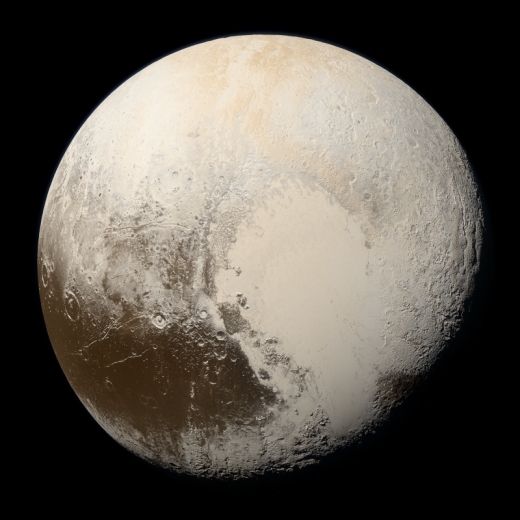
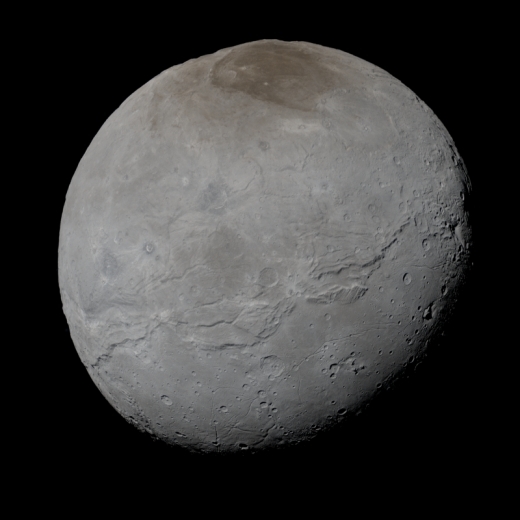
Image: These are the most accurate natural color images of Pluto (top) and its largest moon, Charon (bottom), taken by NASA’s New Horizons spacecraft as it approached the Pluto system on July 14, 2015. Each is a single color scan from the New Horizons Multispectral Visible Imaging Camera. The images here are not to scale; with a diameter of 2,370 kilometers, Pluto is about twice the size of Charon (1207 kilometers). Credit: NASA/Johns Hopkins University Applied Physics Laboratory/Southwest Research Institute/Alex Parker.
No one can predict what kind of memories will stick. The great essayist Michel de Montaigne devalued memory, which was highly prized throughout the European Renaissance. He relied instead, he tells us, on good judgment as the most important part of the human intellectual toolkit. I can’t agree, because for me, good judgment is inextricably bound up with memory. We are both what we learn and what we experience, the two tangled and woven into each other. In any event, New Horizons hit me emotionally and hard not purely because of the scientific return but also because it recalled years of growing up and wondering about Pluto.
We are, as Richard Feynman might have said, the sum of all our histories.
Now we prepare for the flyby of MU69, the object called Ultima Thule, on January 1 of the coming year, with the New Horizons team already readying the spacecraft for the encounter. The spacecraft is now in 3-axis mode, transitioning from spin mode on August 13. We’re 90 percent of the way from Pluto to the KBO as we prepare for the farthest exploration of any planetary body in history.
That’s the thing about space exploration. Not limited like the early sailing vessels to moving about on a finite sphere, we can hope to find something new in almost any direction as we push outward and keep going. We’re coupling digital technologies with human resourcefulness spiced by the kind of dreaming of the unknown that has inspired voyages of all kinds for centuries.
Inevitably, MU69 will trigger its own set of associations because we can’t stop the process even if we wanted to. We humans make memories like oysters make pearls, and memories shape character. Years ago I bought Michael Collins’ book Carrying the Fire in a Sun-flooded Missouri bookstore. Which reminds me of Plutarch, who said, “The mind is not a vessel to be filled. It is a fire to be ignited.” That’s a conflagration that is not easily smothered.
If we have the sense to keep going, there will always be new targets. There will always be new ways to study and explore them. There will always be fire to be gifted to our children.






August 22, 2018
A ‘Flyby’ Model for Early Solar System Evolution
How close would a passing star have to come to produce drastic results on the outer Solar System? According to researchers at the Max Planck Institute for Radio Astronomy in Bonn, roughly 3 times Neptune’s distance would be disruptive enough to explain what we see beyond that planet’s orbit today. Led by Susanne Pfalzner, the scientists have been modeling close stellar flybys of other planetary systems for years, but have only recently turned their attention to the eccentricities of our own system, where conditions beyond Neptune pose questions.

Image: Artist’s concept of a stellar system in the making with a protoplanetary disk surrounding a young star. Credit: NASA JPL-Caltech.
A look at the Solar System’s formation highlights the problematic nature of the process. Out to the orbit of Neptune, planets, dwarf planets and asteroids orbit with only small differences in orbital inclination, indicative of the flatness of the original disk from which all these objects drew their birth materials. But we find that many trans-Neptunian objects move along eccentric, inclined orbits, with objects like Sedna occupying orbits well outside the range of the planets.
What Pfalzner and team added to the mix was another observation: In this distant region, the cumulative mass of the objects we know about drops by almost three orders of magnitude. The assumption is that the outer Solar System must have been modified by processes that took place after its formation. The fact that the drop-off occurs just outside Neptune’s orbit provoked enough interest that the scientists began to perform computer simulations, starting with a young circumstellar disk around the Sun and introducing the close passage of another star.
The result is striking. A star of 0.5 to 1 solar masses moving past our outer system would produce a good fit for the current Solar System, and as we’ll see, in more ways than one:
Starting point of our simulations was the Sun surrounded by a disc, which could either be a protoplanetary or a debris disc, possibly containing already formed planets. We performed an extensive parameter study for the effect of close flybys on discs concentrating on the ones that lead to a steep drop in the mass distribution at 30-35 AU as that observed for the solar system. We found that fly-bys of stars with masses in the range 03.-1.0 M at perihelion distances of between 50 and 150 AU inclined between 50 to 70 degree and at an angle of periastron between 60 to 120 degree are the most promising candidates for a fly-by shaping the outer solar system. Such fly-bys lead to Sednoids, a hot and cold Kuiper belt population and various other properties characteristic for the outer solar system. What distinguishes this model from others, is that only a single event is necessary to create all this features.
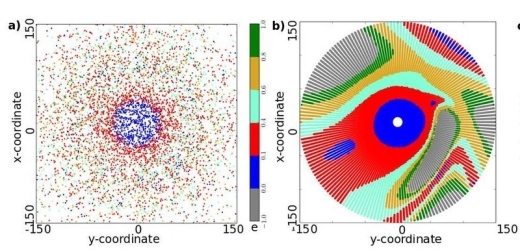
Image: Simulation of the stellar intruder scenario for a mass of 0.5 solar masses and a perihelion distance of 100 astronomical units or 15 billion kilometers for the perturbing star (three times the distance between Sun and Neptune). a) average positions of the particles after the fly-by, colors showing eccentricity of their orbits increasing from blue to green. b) particle positions before the fly-by with different eccentricity populations (colors) from the top row Grey regions: particles that became unbound due to the fly-by event. Credit: S. Pfalzner et al.: The Astrophysical Journal (2018).
As the paper notes, a virtue of this model is its simplicity, allowing a single event (the close flyby) to explain a multitude of features about the current system. For there is another puzzle to be explained: The separation between the giant planets around the Sun increases as their mass decreases with distance from the Sun, which is usually considered to reflect conditions in the protoplanetary disk. But Neptune, with a mass of 17.2 Earths, is more massive than Uranus, at 14.6 MEarth.
The Pfalzner paper explains this, for in its flyby simulations, some portion of the matter beyond Neptune moves inward and concentrates between 30 and 35 AU. In fact, the matter involved corresponds to approximately 1-2 Earth masses, pointing to the possibility that Neptune grew from the incoming material to its present disproportionate size. Some other models have suggested that Neptune and Uranus were originally positioned in opposite order than today and moved to their present positions by gravitational instabilities, an idea the flyby model discounts.
A final note is that the so-called ‘cold Kuiper Belt,’ made up of objects that move on fairly circular, low-inclination orbits, does not fit well with any current planet-scattering models, while it does fit within the parameters of the stellar flyby simulations. Moving to the realm of prediction, these simulations make it clear that if the flyby scenario is correct, many additional outer system bodies at high inclinations may yet be found, perhaps including an object of planetary mass.
Recently we looked at Omega Centauri a cluster whose dense composition caused researchers to question habitability given that planetary orbits were so likely to be disrupted by encounters with other stars. It’s worth remembering that stars like the Sun were born in large groups of stars that were originally densely packed, making stellar encounters more likely.
The numbers from subsequent simulations performed by these researchers are interesting, showing that the odds on such an encounter were fairly high:
Performing simulations of the dynamics of star clusters – gas expulsion, expansion and finding a new quasi-equilibrium – we find that such type of fly-bys are probable not only during the early phases but also on Gyr time scales, with a 5-7% chance of all solar-type stars experiencing such a fly-by during the first 10 Myr and a 20-30% chance in the next Gyr. If planet formation is as fast as anticipated from the ring structures in some discs, even a fly-by during the first 10 Myr would be an option. We showed that the probability of such an event even in the consecutive 4.56 Gyr is competitive to that of other models.
Thus we have an alternative to the ‘Nice Model’ and its offshoots for early Solar System formation, one that manages to explain multiple features of the outer system through a single event rather than a series of gravitational encounters. Calling it a ‘realistic alternative’ to present models, Pfalzner points out that it remains a hypothesis, but one intriguing in its simplicity.
The paper is Pfalzner et al., “Outer Solar System Possibly Shaped by a Stellar Fly-by,” The Astrophysical Journal, Vol. 863, No. 1 (09 August 2018). Abstract / preprint.






August 21, 2018
New Insights into Beta Pictoris b
Beta Pictoris b continues to instruct us in the ways of exoplanet finding. Consider: The young world was identified in 2008 through direct imaging via the Very Large Telescope at the European Southern Observatory site at Cerro Paranal (Chile). Actually seeing an exoplanet is no small feat. We are in this case talking about a bright A-class star some 63 light years away in the wash of whose light we can pick out a comparatively small planet. But it was also a young planet, putting out plenty of heat amidst the large debris disk, the first such disk ever imaged.
The earliest detections of planets around main sequence stars have involved radial velocity, using Doppler methods that can tell us the rate at which the star moves toward and then away from the Earth as it is affected by the planet orbiting it. But radial velocity is a tough call at Beta Pictoris because these changes are tiny, and we are dealing with a star those fast rotation and stellar pulsations obscure the needed signal. Radial velocity, in other words, is far more suited to planets in systems that are well beyond the early period of planet formation.
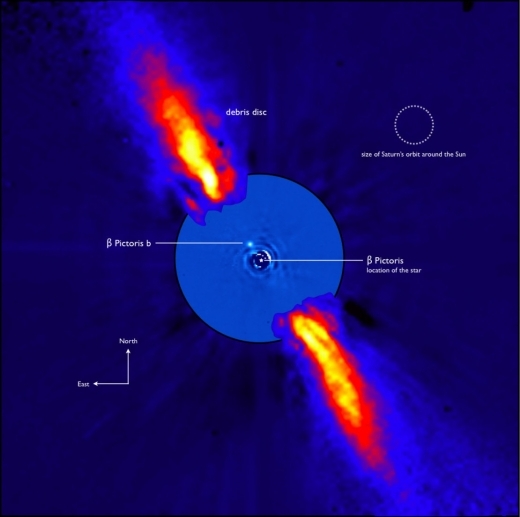
Image: The planet Beta Pictoris b is visible orbiting its host star in this composite image from the European Southern Observatory’s (ESO) 3.6-m telescope and the NACO instrument on ESO’s 8.2-m Very Large Telescope. The Beta Pictoris system is only about 20 million years old, roughly 225 times younger than the Solar System. Observing this dynamic and rapidly evolving system can help astronomers shed light on the processes of planet formation and early evolution. Credit: ESA.
Now we have what is being called the first successful estimate of a young planet’s mass taken by means of astrometry. Rather than measuring the star’s ‘wobble’ along the line of sight, as we do with radial velocity methods, the new astrometric data allow scientists to measure its deviations on the plane of the sky. Crucial to the work is a lengthy period of observation, which means taking advantage not only of data from the Gaia mission but also the older Hipparcos mission. The latter observed Beta Pictoris 111 times between 1990 and 1993.
Gaia’s second data release includes 22 months of observations, including 30 observations of Beta Pictoris. The combined measurements, examined by Ignas Snellen and Anthony Brown (Leiden University, The Netherlands) show the star’s long-term proper motion. Essentially, the scientists have measured the deviation from what would have been expected of a star without a planet, interpolating the mass of the planet from the size of this deviation.
“By combining data from Hipparcos and Gaia, which have a time difference of about 25 years, you get a very long term proper motion,” adds Brown. “This proper motion also contains the component caused by the orbiting planet. Hipparcos on its own would not have been able to find this planet because it would look like a perfectly normal single star unless we had measured it for a much longer time. Now, by combining Gaia and Hipparcos and looking at the difference in the long term and the short term proper motion, we can see the effect of the planet on the star.”
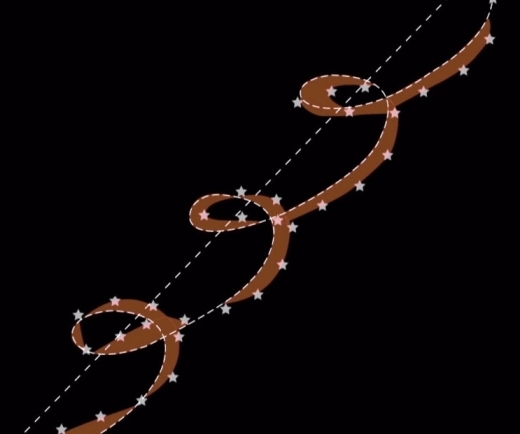
Image: Astronomers can measure the mass of exoplanets by looking at tiny deviations in the trajectories of their host stars caused by the gravitational pull of the orbiting planets. These can be observed either along the line of sight, looking for small changes in a star’s radial velocity, or on the plane of the sky, using astrometric measurements. To be able to make accurate assessments, the astrometric observations need to cover a period of many years. In this picture, the white dashed spiral shows the evolution of a star’s trajectory observable from the Earth, caused by the combination of parallax and proper motion. The brown band shows the range of deviations of the star’s trajectory caused by a possible planet orbiting it. Credit: ESA.
We learn from all this that Beta Pictoris b is a gas giant of between 9 and 13 times the mass of Jupiter. Useful in itself, the finding also highlights what we can expect from Gaia in the years ahead. Thousands of exoplanets are expected to be discovered in the course of the mission, but the tiny astrometric wobbles being sought can only be detected over sufficiently long periods of time, which is why the windfall of Gaia planets isn’t expected until late in the mission.
As to where this work fits in on the spectrum of young exoplanet studies, we see in Beta Pictoris b and other examples of young gas giants the chance to study the formation and evolution of such worlds. Thus far we have had no reliable mass measurements to distinguish between different formation models. The new Beta Pictoris b work implies a planet that has formed from gravitational instability, with disk gas collapsing to form the planet. Such a mechanism, with the infant giant planet retaining most of it initial entropy, is sometimes called a ‘hot start.’
The authors go on to point out that the collection of data leading to mass measurements for other young gas giants will help to constrain other models of early planetary evolution.
The paper is Snellen & Brown, “The mass of the young planet Beta Pictoris b through the astrometric motion of its host star,” Nature Astronomy 20 August 2018 (abstract).






August 20, 2018
The Prevalence of ‘Water Worlds’
The first time I ran into the term ‘water world,’ it had a seductive quality. After all, we think of habitable zones in terms of water on the surface, and a world with an overabundance of water suggested a kind of celestial Polynesia, archipelagos surrounded by a planet-circling, azure sea.
But we immediately run into problems when we think about planets with substantially more water than Earth. For one thing, we may have no land at all. Let’s leave aside the icy moons of our Solar System that may well contain oceans beneath their surface and concentrate on exoplanets in the interesting size range of two to four times the size of Earth. We have to ask what would happen if a planet were completely covered with water, with no run-off of nutrients from exposed rock. Such an ocean could be starved of key elements like phosphorus.
Or how about a planet with a high-pressure zone of ice effectively cutting off the global ocean from the rocky mantle? A world with enough water — 50 times that of Earth has been considered — could create enough pressure on the seafloor to prevent geological activity, blocking the kind of carbon-silicate cycle that adjusts the atmospheric composition we find here on Earth. Cayman Unterborn (Arizona State) thinks liquid water on the 5th planet in the TRAPPIST-1 system could be as much as 200 kilometers deep, 20 times deeper than the Marianas Trench.
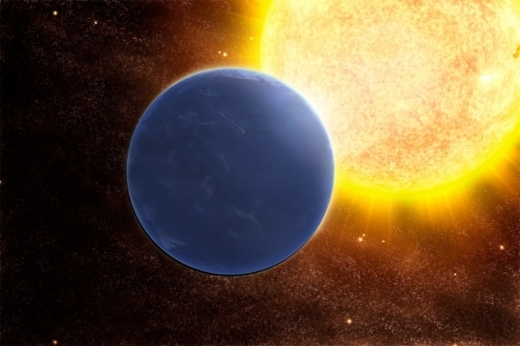
Image: A water world as envisioned in a photo-illustration by Christine Daniloff/MIT/ESO.
We don’t want to be too doctrinaire about this. For instance, Ramses Ramirez (Tokyo Institute of Technology) and Amit Levi (Harvard-Smithsonian Center for Astrophysics), have argued that there are ways to exchange greenhouse gases between deep sea ice and the atmosphere (citation below). In other words, we can have a carbon cycle without rock weathering, subject to a number of constraints like stellar type (hotter stars work best here) and rotation rate (thanks to Alex Tolley for his overview of this paper in private correspondence).
This is a work I hope to write about soon, but for now, let me quote from an essay by Shannon Hall on the topic that cites both Ramirez and Edwin Kite (University of Chicago), with a useful reminder from both on not being too quick to limit our thinking to Earth-centric models:
“What I’ve taken away from this project is the inadequacy of working from Earth’s analogy,” says Kite, admitting this conclusion is ironic given that he is a geologist by training. “I love rocks and Earth-history, but you really need to build up from basic physics and chemistry, rather than relying on Earth’s analogy in order to tackle exoplanet problems.” This consideration will be important when astronomers have to determine which individual worlds to further assess with large telescopes like the James Webb Space Telescope or when they have to choose between future missions that would survey hundreds of worlds and those that would study a handful of Earth clones in detail. But there is no consensus yet. “I think it could be dangerous just thinking about everything in an Earth-mindset,” Ramirez says. “You might be missing out on other possibilities.”
Exactly so, and when telescope time is precious, as it will continue to be for all our space-based resources in particular, target selection is critical. Meanwhile, I’ve run across the presentation that Li Zeng (Harvard University) and colleagues made at the recent Goldschmidt conference in Boston. The researchers point to data from both Kepler and the Gaia mission indicating that many known exoplanets may contain as much as 50 percent water. Here we can definitely toss the Earth-centric model out the window. Consider that Earth’s water content is 0.02% by weight. If these data are correct, huge numbers of exoplanets are entirely awash.
Zeng and team have been developing a model of the internal structure of two kinds of exoplanets: Those with a radius averaging about 1.5 times that of Earth, and those averaging 2.5 times Earth’s radius. According to their developing model, those with a radius 1.5 times the Earth’s are generally rocky planets, perhaps five times as massive as the Earth. Those with a radius 2.5 times that of Earth, massing about 10 Earth masses, are likely water worlds.
The model the researchers have developed tracks the changes in mass and radius when planets grow from a rocky core and later accrete either ices or hydrogen/helium gas, with the observed radius and mass-radius distribution reproduced in the model’s simulations. Many of the interesting planets in this range turn out to be water worlds.
“Our data indicate that about 35% of all known exoplanets which are bigger than Earth should be water-rich,” says Zeng. “These water worlds likely formed in similar ways to the giant planet cores (Jupiter, Saturn, Uranus, Neptune) which we find in our own solar system. The newly-launched TESS mission will find many more of them, with the help of ground-based spectroscopic follow-up. The next generation space telescope, the James Webb Space Telescope, will hopefully characterize the atmosphere of some of them. This is an exciting time for those interested in these remote worlds.”
On the larger planets, we can throw out my fanciful ‘Polynesia’ model. The researchers believe the surface temperature here would be in the range of 200 to 500 degrees Celsius. We would see an atmosphere dominated by water vapor, with a liquid water layer beneath, and high-pressure ices below. Our next generation of telescopes can put these ideas to the test.
“It’s amazing to think that the enigmatic intermediate-size exoplanets could be water worlds with vast amounts of water,” says MIT planet-hunter Sara Seager. “Hopefully atmosphere observations in the future–of thick steam atmospheres—can support or refute the new findings.”
The abstract for the Zeng et al. presentation at the Goldschmidt Conference, “Growth Model Interpretation of Planet Size Distribution,” is here. The Unterborn paper is “Inward migration of the TRAPPIST-1 planets as inferred from their water-rich compositions,” Nature Astronomy 19 March 2018 (abstract). The Ramirez and Levi paper is “The Ice Cap Zone: A Unique Habitable Zone for Ocean Worlds,” Monthly Notices of the Royal Astronomical Society 477, 4 (2018), 4627-4640 (abstract / preprint).






August 17, 2018
The Breakthrough Starshot Opportunity
When we think about what is usually called ‘planetary protection,’ we’re talking about the probes we send to possibly life-bearing places like Mars or Europa. It would confound our investigations if we couldn’t be sure we hadn’t contaminated such a place with microorganisms from Earth, unwittingly carried aboard a lander that was not properly stripped of such passengers. Even our Cassini Saturn orbiter was guided into the planet as a way of ensuring that it would not, at some future date, crash into a place as biologically interesting as Enceladus.
Yesterday, having looked at an essay by Ethan Siegel, I asked rhetorically whether we should think up some kind of exoplanetary protection policy as well. After all, we’re fleshing out an actual mission design through Breakthrough Starshot, aiming to reach nearby stars in coming decades. Siegel (Lewis & Clark College) had expressed his concern that Breakthrough Starshot might inadvertently start an interstellar war. The idea is extreme, but I use the word ‘war’ because it was right there in the title of Siegel’s piece.
What Siegel worries about is that among the large number of payloads Breakthrough Starshot would like to send to nearby stars there might be one that accidentally impacted the planet under study. He’s concerned about the ‘cone of uncertainty’ that would be involved in any trajectory aimed at making a close pass of a planet like Proxima b and argues that at 60,000 km/sec, which is the Starshot goal of 20 percent of c, a tiny 1-gram payload will strike with the force of a 1 tonne asteroid moving at 60 km/sec, a hit like Chelyabinsk.
Harvard’s Avi Loeb, who chairs the Breakthrough Starshot advisory board, finds little merit in the concern. I had been wondering as I wrote yesterday’s post just what Dr. Loeb would have to say about Siegel’s views, only to find an email with a link to his new essay in Forbes in my mailbox shortly after I published — his piece had already appeared that morning. Loeb points out that at a tenth of the speed of light, a payload of Starshot size would “…merely carry the energy of a common asteroid, only a few meters in size — of order the height of a person. Such asteroids hit the Earth a few times per year and burn up in the atmosphere.”
Here is a map of asteroid impacts that Loeb linked to in his essay.
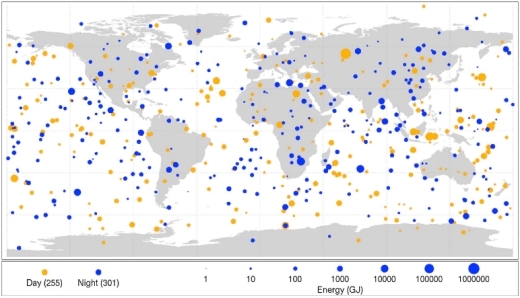
Image: This diagram maps the data gathered from 1994-2013 on small asteroids impacting Earth’s atmosphere to create very bright meteors, technically called “bolides” and commonly referred to as “fireballs”. Sizes of red dots (daytime impacts) and blue dots (nighttime impacts) are proportional to the optical radiated energy of impacts measured in billions of Joules (GJ) of energy, and show the location of impacts from objects about 1 meter (3 feet) to almost 20 meters (60 feet) in size. Credit: Planetary Science.
The map, the work of NASA’s Near Earth Object Program, is instructive. All told, 556 small asteroids impacted our atmosphere in a 20-year period, almost all of them disintegrating in the atmosphere, with the obvious exception of the Chelyabinsk event, which was caused by the largest asteroid to strike in this timeframe. My understanding about Chelyabinsk is that the meteor was approximately 20 meters in size, moving at roughly 19 kilometers per second.
But wouldn’t a one-gram payload moving at Starshot speeds still wreak havoc if it fell on a planetary surface? Evidently the event wouldn’t happen. Let me quote Loeb on this:
…a gram-scale starchip would burn up in the atmosphere of a planet much more easily than a tonne-mass asteroid. Its impact on a planet would be no more irritating than the impact of a dust grain on the skin of a grazing cow. The interplanetary medium is full of debris that poses far greater risks to a planet, as the dinosaurs realized when wiped out by the impact of a 10-15 kilometer asteroid (a trillion times more massive than we just considered) some sixty five million years ago.
In any case, Loeb sees the chances of collision at something less than one part in a million, given the fact that knowing the relative positions of planet and spacecraft over a journey lasting decades is impossible with the payload as envisioned. What Breakthrough Starshot does expect is a closest approach thousands of times larger than the surface of any planet.
We should pause on the deceleration question, which comes up repeatedly whenever I talk about Starshot probes with people new to the project. While it is certainly true that deceleration and orbit in, say, the Proxima Centauri system would be a huge benefit, there is no way to make it happen given the current constraints on the payload, which relies on miniaturization and nonetheless requires vast energies to be brought up to cruising speed. Our initial interstellar efforts will surely be flybys for this reason, and there is a wealth of science that can be gathered.
The other thing to be remembered is that Breakthrough Starshot is an ongoing effort to demonstrate the feasibility of beamed laser sail technologies. Submissions from the first Requests for Proposals are being evaluated as sail stability and materials are considered by way of moving toward experimental work in what we can hope will be a dedicated sail facility. The laser array that would drive these craft presents huge challenges of its own, as do the many other issues, like communications, that will have to be resolved before any interstellar mission can be flown.
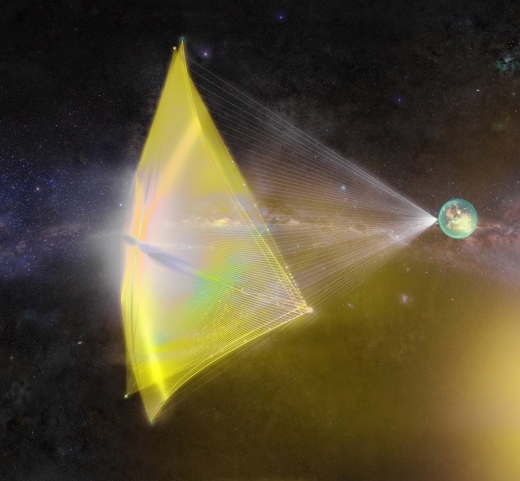
We’re looking at an interstellar capability that, if everything were to go well, would still take 30 years to produce a working infrastructure. To those new to Breakthrough Starshot, I recommend looking at the list of technical problems that face the project as it determines whether the concept is sound enough to move to prototype stage enroute to a full deployment. This is going to take time, and we won’t know for quite a while whether the Starshot concept, as is, is workable.
What we do already know is that the commitment of resources underlying the project is already paying off, and will continue to pay off, in the form of newly funded research.
Anyone familiar with the history of interstellar flight studies will know how rare it is to have this level of cooperation and participation among the scientists best equipped to tackle the problem. For most of the past century, researchers interested in the interstellar conundrum did their work in their spare time and met only at the occasional conference, with infrequent journal articles maintaining the thread. The research Breakthrough Starshot will produce will thus be a solid advance for the entire field, no matter if, when or how often the actual missions are flown.






August 16, 2018
On the Enigma of Arrival
The death of V.S. Naipaul (1932-2018), that cross-grained and all too combative man who saw so unflinchingly into the post-colonial lands from which he drew his heritage, invariably brings to mind his strangest novel, The Enigma of Arrival (Vintage Books, 1987). Temporarily settled into a cottage in Wiltshire in rural England, the author looks back on his career in search of a renewal as cyclic as the seasons. Landscape inspires creativity in this deeply visualized microcosm, even as Naipaul broods over the painting that gives the book its title.
The novel is an odd, self-indulgent work, one I completed more out of a sense of duty (I was reviewing it for a newspaper) than enthusiasm. Yet its introspective imagery keeps resonating. Naipaul was obsessed with the sub-story of the painting, showing the arrival of a visitor at a strange port city and implying a subsequent journey that would in some way parallel his own career.
The work of Giorgio de Chirico (1888-1978), ‘The Enigma of Arrival and the Afternoon’ is a canvas showing this surreal cityscape, a world fitting into Naipaul’s autobiographical meditation with its characters disembarked in a place suggestive of antiquity under a brooding Levantine sky.
A classical scene, Mediterranean, ancient-Roman — or so I saw it [writes Naipaul]. A wharf; in the background, beyond walls and gateways (like cutouts), there is the top of the mast of an antique vessel; on an otherwise deserted street in the foreground there are two figures, both muffled, one perhaps the person who has arrived, the other perhaps a native of the port. The scene is of desolation and mystery…

Which gets us to interstellar flight and other, more exotic arrivals. I’ve always believed that if we ever do discover hard evidence of an extraterrestrial civilization, that experience will not translate into trade opportunities or galactic encyclopedias but mysteries that leave us in some ways more baffled about the nature of intelligence than ever before. I draw a distinction here between ‘contact’ and ‘encounter,’ which are entirely different things, and wonder what this kind of arrival would look like to humans finding evidence for extraterrestrial intelligence.
Here I’ll invoke the splendid novel Roadside Picnic, by Arkady and Boris Strugatsky (1971). Alien artifacts appear at various places on Earth, so-called ‘zones of visitation’ filled with bizarre items, many of them dangerous, and inexplicable happenings. Unseen themselves, the aliens are glimpsed only through what they leave behind in our region of spacetime before moving on. Protagonist “Red” Schuhart is a ‘stalker,’ one who defies the danger to enter the alien zones in search of artifacts. What happens in a Zone can never be predicted.
He had never experienced anything like this before outside the Zone. And it had happened in the Zone only two or three times. It was as though he were in a different world. A million odors cascaded in on him at once—sharp, sweet, metallic, gentle, dangerous ones, as crude as cobblestones, as delicate and complex as watch mechanisms, as huge as a house and as tiny as a dust particle. The air became hard, it developed edges, surfaces, and corners, like space was filled with huge, stiff balloons, slippery pyramids, gigantic prickly crystals, and he had to push his way through it all, making his way in a dream through a junk store stuffed with ancient ugly furniture … It lasted a second. He opened his eyes, and everything was gone. It hadn’t been a different world—it was this world turning a new, unknown side to him. This side was revealed to him for a second and then disappeared, before he had time to figure it out.
Ursula Le Guin was quick to note the connection between the Strugatskys and the work of Stanislaw Lem, the great Polish novelist whose Solaris (1961) is widely admired and twice filmed. Here too, coping with a planet-wide ocean with its own kind of sentience, the human characters come up hard against their own preconceptions and the failure of their paradigms to understand an alien presence. Lem chided what he called ‘the myth of our cognitive universalism,’ a myth the Strugatsky’s equally exploit in the ravishingly strange Roadside Picnic. Like Naipaul, Lem has his own obsession with arrivals.
“We don’t want to conquer the cosmos, we simply want to extend the boundaries of Earth to the frontiers of the cosmos… We are searching for an ideal image of our own world: we go in quest of a planet, a civilization superior to our own but developed on the basis of a prototype of our primeval past. At the same time, there is something inside us which we don’t like to face up to, from which we try to protect ourselves, but which nevertheless remains, since we don’t leave Earth in a state of primal innocence. We arrive here as we are in reality, and when the page is turned and that reality is revealed to us – that part of our reality which we would prefer to pass over in silence – then we don’t like it anymore.”
Is an arrival always a wakening of self-knowledge? Here I might also mention Arthur C. Clarke’s Rendezvous with Rama (1973), in which an alien starship passes through the Solar System, an approach that reminded many Centauri Dreams readers of the recent appearance of ‘Oumuamua. A survey vessel despatched to study the object called Rama discovers geometric structures and a ‘cylindrical sea,’ along with an atmosphere that turns out to be breathable. But Rama will not tarry. After a gravitational slingshot maneuver, it departs the Solar System for the Magellanics.
It is an arrival wrapped in mystery but, as Clarke goes on, “at least we have answered one ancient question. We are not alone. The stars will never again be the same to us.”
Could anything ever be the same? In tales like these, we confront the unknowable in disturbing ways, conflicted by our inability to establish the kind of contact that would explain and enlarge our own existence. No one can know what an actual alien contact might involve, but I suspect that dealing with an entirely separate lifeform deriving from an evolution under wholly different skies will prove to be as enigmatic as anything written by the Strugatskys, Lem or Clarke.
Arrival as Threat?
In that vein, I recently ran across an essay by astrophysicist Ethan Siegel, sent on by several readers who knew how often we’ve discussed Breakthrough Starshot in these pages. What Siegel does is to reverse the story. He wonders how the recipients of an arrival from Earth would react, and speculates that if we’re not careful, we may send entirely the wrong signal.
Breakthrough Starshot, after all, envisions pushing a fleet of small sails carrying payloads of a gram or so to a nearby stellar system. Right now the obvious target is Proxima Centauri, where we know we have a planet in the habitable zone, but we may find equally promising possibilities around Centauri A or B. The goal here is not contact but simply the opportunity to perform flybys of an interesting planet and return data and imagery, and Siegel is quick to note that sails boosted to 20 percent of lightspeed have no deceleration mechanism available to them.
The problem: A ‘cone of uncertainty’ exists for any trajectory that will take us close enough to the planet to retrieve good data, an aiming problem requiring unprecedented levels of precision. Thus the possibility that we could be entering an inhabited stellar system and colliding with a living world cannot be ruled out. Siegel notes the invariable relationship between kinetic energy and speed: Double the speed and you get four times the energy. Even our tiny 1-gram spacecraft moving at 60,000 km/sec, says Siegel, will hit with the force of a 1 tonne asteroid moving at 60 km/sec, which in effect means we could cause a Chelyabinsk-like event, or more than one.
If you were an alien on this world that got struck by these relativistic masses, what would you conclude? You’d know that these were too massive and too fast-moving to be created naturally; they were made by an intelligent civilization. You’d know that you were being intentionally targeted; space is too vast for these to strike you by random chance. And — worst of all — you’d assume this civilization had a malicious intent. No benevolent aliens would launch something so recklessly and carelessly given the damage it would cause. If we’re smart enough to send a spacecraft across the galaxy to another star, surely we can be wise enough to reckon the disastrous consequences of doing so.
What an arrival this would be. And yet, in order to study nearby worlds, we have yet to come up with a plan remotely as feasible as the admittedly longshot Breakthrough Starshot. Are there ways we can minimize this risk or eliminate it altogether while still finding a way to begin interstellar explorations? Because we do need to consider how we are perceived when we probe into the utterly unknown, and if the odds seem long that there is a civilization on Proxima b or that we might inadvertently hit the planet we are studying, they are still not zero.
The enigma of arrival is magnified and transformed when we are arriving at a place we are seeing for the first time, just as our arrival at Pluto/Charon opened up two worlds while posing new mysteries about the surfaces we flew past. Naipaul referred to de Chirico’s scene as the depiction of ‘a dangerous classical city,’ one in which the newcomer sought orientation and meaning. How much more enigmatic might our own arrival be if perceived by other intelligences? Should the need for ‘exoplanetary protection’ join our other mission parameters?
[Addendum]: Be sure to look at Avi Loeb’s spirited response to Siegel in Why Humanity Probably Won’t Accidentally Start An Interstellar War With An Alien Civilization. More on this tomorrow.






August 15, 2018
Omega Centauri: Improbable Venue for Life?
Although it appears in the same constellation as seen from Earth (Centaurus), Omega Centauri has nothing to do with the Alpha Centauri stars that so interest interstellar flight theorists. The brightest globular cluster visible in our skies, Omega Centauri is anything but close (16,000 light years out) and, containing several million stars, is the largest globular cluster in our galaxy. We may in fact be looking at the core of a dwarf galaxy once absorbed by the Milky Way.
But although it’s quite distant, Omega Centauri may be the source of the relatively nearby Kapteyn’s Star, just 13 light years from the Sun. Where this gets intriguing is that Kapteyn’s Star, (named after Dutch astronomer Jacobus Kapteyn) is known to have at least two planets, one of them considered the oldest known potentially habitable planet — let’s call it a ‘temperate Super-Earth’, as Guillem Anglada-Escudé and team have done — at 11 billion years old.
Steven Kane (UC-Riverside), working with graduate student Sarah Deveny (San Francisco State) has now produced a paper taking a deep dive into Omega Centauri and its own prospects for habitability. Beginning with 470,000 stars in the cluster’s core, the duo focused on a subset of 350,000 of these, using color as a gauge of temperature and age in making their choice. The idea was to calculate habitable zones around each star, in which a rocky world might have liquid water on the surface.
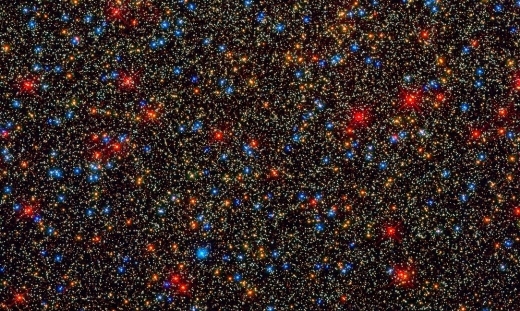
Image: There are colorful stars galore, but likely no habitable planets, inside the globular star cluster Omega Centauri. Credit: NASA, ESA, AND THE HUBBLE SM4 ERO TEAM.
The paper Kane and Deveny produced makes the point that most exoplanet searches have occurred around field stars, but globular clusters are attractive hunting grounds given the age of their stars and the possibility they offer to study planet formation and evolution as affected by the cluster. But so far planet hunting in such clusters has not proven profitable. A 2000 study using the Hubble instrument to study 34,000 stars in the core of the cluster 47 Tucanae revealed not a single transit, nor did follow-ups in the less crowded outer regions of the cluster.
Nor have transiting planets been found in the cluster NGC 6397. Undaunted, Kane and Deveny here analyze Hubble data on the core of Omega Centauri and calculate habitable zones for the observed stars. The idea is to determine how conditions in the Omega Centauri core affect the potential habitability of planets around main sequence stars, the latter being determined by a color-magnitude diagram with data drawn from filters described in the paper. Luminosity and effective temperatures were calculated using Hubble instrument filters from the Dartmouth Stellar Evolution Database, assuming 11.5 billion years as the age in the applied model.
Kane and Deveny use habitable zone relationships and methodologies found in the literature, going on to calculate the conservative habitable zone (CHZ) and optimistic habitable zone (OHZ), boundaries that Kane previously used in creating a catalog of Kepler habitable zone planets. Given the star properties determined by the above analysis, which showed that the sample under consideration was dominated by low-mass stars, the researchers found that about 50 percent of the sample had an outermost habitable zone boundary within 0.5 AU of the star.
No surprise there, as most of the stars in the Omega Centauri core are red dwarfs, implying habitable zones much closer than those around G- and K-class stars. Compact planetary systems of the kind we see, for example, around small M-dwarfs like TRAPPIST-1 would seem to stand a better chance of survival from disruption by nearby stars, but conditions here are truly tight. Our Sun has a separation of over 4 light years from its nearest stellar neighbors, but within Omega Centauri’s core, the average distance is a scant 0.16 light years. That would set up frequent encounters between stars, on the order of one every 1 million years.
The result does not bode well for these planets, as the paper notes:
…the compact nature of the HZ regions is more than offset by the potential disruption of planetary systems, where close encounters of only 0.5 AU are expected to occur on average every 1.65 × 106 years. Though the large resulting population of free-floating terrestrial planets are intrinsically interesting from formation and dynamical points of view, the potential for habitability in the ω Cen core environment is significantly reduced by such scattering events. The primary lesson that can be extracted from this analysis is the underlining of the importance of quantifying the long-term dynamical stability of orbits inside HZ regions taking into account both internal (planetary) dynamics and external (stellar) interactions.
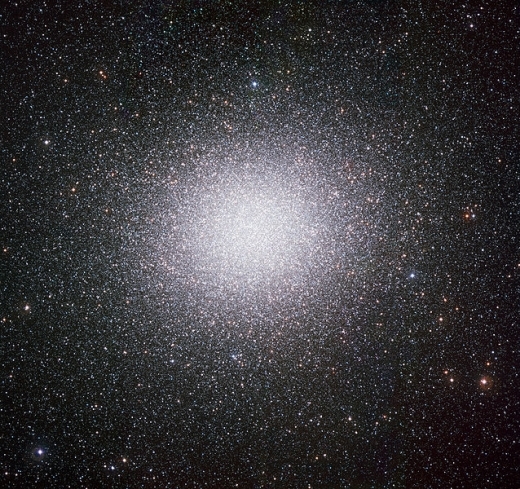
Image: The globular cluster Omega Centauri — with as many as ten million stars — is seen in all its splendor in this image captured with the WFI camera from ESO’s La Silla Observatory. The image shows only the central part of the cluster — about the size of the full moon on the sky (half a degree). North is up, East is to the left. This colour image is a composite of B, V and I filtered images. Note that because WFI is equipped with a mosaic detector, there are two small gaps in the image which were filled with lower quality data from the Digitized Sky Survey. Credit: ESO.
Because we have no firm knowledge of how common planets are in this environment, we’re left to speculate, but the paper’s calculations show that numerous compact planetary systems could exist in Omega Centauri. But even assuming a large population of rocky worlds, cluster dynamics would keep encounters between these planetary systems happening on a regular basis. The scenario of planets stripped from their host stars seems inimical to life.
But a possibility remains. Terrestrial-class worlds disrupted from their home systems could constitute a large population of free-floating worlds that might be analyzed through gravitational microlensing. There are some studies in the literature arguing that free-floating worlds with a thick hydrogen atmosphere could retain habitable conditions at the surface, so as the authors note, habitable planets cannot be entirely ruled out despite the problem of stability.
And, of course, encounter rates between stars will vary depending on the size and density of the cluster:
“The rate at which stars gravitationally interact with each other would be too high to harbor stable habitable planets,” Deveny said. “Looking at clusters with similar or higher encounter rates to Omega Centauri’s could lead to the same conclusion. So, studying globular clusters with lower encounter rates might lead to a higher probability of finding stable habitable planets.”
Such studies will doubtless be pursued. After all, the close separation among ancient stars at a globular cluster’s core would seem to give any civilizations that formed near them the opportunity to explore nearby systems and eventually the entire cluster. We’ve talked before about the work of Rosanne Di Stefano (Harvard-Smithsonian Center for Astrophysics), who makes this case (see Globular Clusters: Home to Intelligent Life?). Says Di Stefano:
“Interstellar travel would take less time… The Voyager probes are 100 billion miles from Earth, or one-tenth as far as it would take to reach the closest star if we lived in a globular cluster. That means sending an interstellar probe is something a civilization at our technological level could do in a globular cluster.”
In fact, Di Stefano argues that portions of many globular clusters other than the core can be considered ‘sweet spots’ where habitable orbits are stable for long periods. So the question of habitability and planet formation itself inside globular clusters is one of continuing interest.
One thing is clear. When we talk about habitable zones, we have to take into account the dynamical stability of the orbits involved, examining not just the planets themselves but the possibility of encounters with nearby stars. In dense environments, such interactions and the scattering they cause would be game-changers. Cluster outskirts may offer better opportunities.
The paper is Kane and Deveny, “Habitability in the Omega Centauri Cluster,” accepted at The Astrophysical Journal (preprint). The Di Stefano paper mentioned above is “Globular Clusters as Cradles of Life and Advanced Civilizations,” Astrophysical Journal Vol. 827, No. 1 (5 August 2016). Abstract.






Paul Gilster's Blog
- Paul Gilster's profile
- 7 followers



